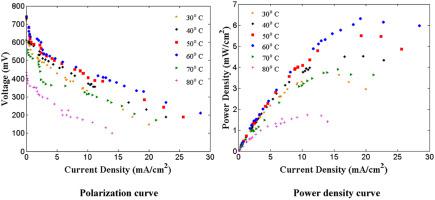Journal of Environmental Chemical Engineering ( IF 7.4 ) Pub Date : 2021-07-27 , DOI: 10.1016/j.jece.2021.106119 Diyan ul Imaan 1 , Fasil Qayoom Mir 2 , Babar Ahmad 1

|
A series of proton exchange membranes (PEMs) are fabricated by using an inexpensive organic poly (vinyl alcohol) as the base and inorganic alpha alumina as the filler/ionomer of the membrane. The physical, mechanical and thermal characterization of the synthesized membranes are carried out by using tools such as Fourier transform-infrared (FT-IR), X-ray diffraction (XRD), scanning electron microscope (SEM), nanoindentation, universal testing machine (UTM), and thermogravimetric analysis (TGA). UTM results depict that the membranes possess high mechanical stability (tensile stability up to 80.4 MPa) where as TGA results establish the high thermal performance (stable up to 260 °C) of the membranes. Other important performance parameters like the water uptake, methanol uptake, and swelling ratio are determined. The chemical stability of the membranes is also evaluated. The electrochemical properties like the ion exchange capacity (max 0.59 meq/g), the transport number (max 0.72) and the proton conductivity (max 2.9 mS/cm) are calculated. A single-cell DMFC performance testing is carried out at different temperatures. The maximum open-circuit voltage of 0.74 V, current density of 28.4 mA/cm2 and power density of 6.3 mW/cm2 are obtained at 60 °C.
中文翻译:

以聚乙烯醇为载体,α氧化铝为填料的质子交换膜及其在直接甲醇燃料电池中的性能
一系列质子交换膜 (PEM) 是通过使用廉价的有机聚(乙烯醇)作为基础和无机 α 氧化铝作为膜的填料/离聚物制造的。通过使用傅里叶变换红外(FT-IR)、X射线衍射(XRD)、扫描电子显微镜(SEM)、纳米压痕仪、万能试验机等工具对合成膜进行物理、机械和热表征。 UTM) 和热重分析 (TGA)。UTM 结果表明膜具有高机械稳定性(拉伸稳定性高达 80.4 MPa),而 TGA 结果表明膜具有高热性能(稳定高达 260 °C) 膜。其他重要的性能参数,如吸水率、甲醇吸收率和溶胀率也被确定。还评估了膜的化学稳定性。计算离子交换容量(最大 0.59 meq/g)、传输数(最大 0.72)和质子电导率(最大 2.9 mS/cm)等电化学特性。在不同温度下进行单电池 DMFC 性能测试。在60 ℃下获得0.74 V的最大开路电压、28.4 mA/cm 2 的电流密度和6.3 mW/cm 2 的功率密度。











































 京公网安备 11010802027423号
京公网安备 11010802027423号